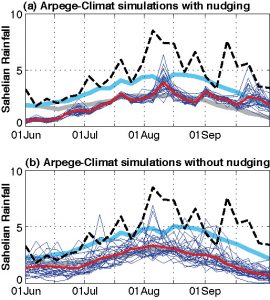l’article du mois – août 2011
 Diagnosing GCM errors over West Africa using relaxation experiments. Part II: intraseasonal variability and African easterly waves
Diagnosing GCM errors over West Africa using relaxation experiments. Part II: intraseasonal variability and African easterly waves
par Benjamin Pohl (CRC) et Hervé Douville (Météo-France)
publié en ligne dans la revue Climate Dynamics
A near-global grid-point nudging of the Arpege-Climat atmospheric General Circulation Model towards ECMWF reanalyses is used to diagnose the regional versus remote origin of the summer model biases and variability over West Africa. First part of this study revealed a limited impact on the monsoon climatology compared to a control experiment without nudging, but a significant improvement of interannual variability, although the amplitude of the seasonal anomalies remained underestimated. Focus is given here on intraseasonal variability of monsoon rainfall and dynamics. The reproducible part of these signals is investigated through 30-member ensemble experiments computed for the 1994 rainy season, a year abnormally wet over the Sahel but representative of the model systematic biases. In the control experiment, Arpege-Climat simulates too few rainy days that are associated with too low rainfall amounts over the central and western Sahel, in line with the seasonal dry biases. Nudging the model outside Africa tends to slightly increase the number of rainy days over the Sahel, but has little effect on associated rainfall amounts. However, results do indicate that a significant part of the monsoon intraseasonal variability simulated by Arpege-Climat is controlled by lateral boundary conditions. Parts of the wet/dry spells over the Sahel occur in phase in the 30 members of the nudging experiment, and are therefore embedded in larger-scale variability patterns. Inter-member spread is however not constant across the selected summerseason. It is partly controlled by African Easterly Waves, which show dissimilar amplitude from one member to another, but a coherent phasing in all members. A lowpass filtering of the nudging fields suggests that low frequency variations in the lateral boundary conditions can lead to eastward extensions of the African Easterly Jet, creating a favorable environment for easterly waves, while high frequency perturbations seem to control their phasing.
Pohl B & H Douville (2011) Diagnosing GCM errors over West Africa using relaxation experiments. Part II: Intraseasonal variability and African easterly waves. Climate Dynamics, published on line. doi:10.1007/s00382-011-1106-1
- extrait:
- lien_externe:
- kc_data:
- a:8:{i:0;s:0:"";s:4:"mode";s:0:"";s:3:"css";s:0:"";s:9:"max_width";s:0:"";s:7:"classes";s:0:"";s:9:"thumbnail";s:0:"";s:9:"collapsed";s:0:"";s:9:"optimized";s:0:"";}
- kc_raw_content:
 Diagnosing GCM errors over West Africa using relaxation experiments. Part II: intraseasonal variability and African easterly waves
Diagnosing GCM errors over West Africa using relaxation experiments. Part II: intraseasonal variability and African easterly waves
par Benjamin Pohl (CRC) et Hervé Douville (Météo-France)publié en ligne dans la revue Climate Dynamics
A near-global grid-point nudging of the Arpege-Climat atmospheric General Circulation Model towards ECMWF reanalyses is used to diagnose the regional versus remote origin of the summer model biases and variability over West Africa. First part of this study revealed a limited impact on the monsoon climatology compared to a control experiment without nudging, but a significant improvement of interannual variability, although the amplitude of the seasonal anomalies remained underestimated. Focus is given here on intraseasonal variability of monsoon rainfall and dynamics. The reproducible part of these signals is investigated through 30-member ensemble experiments computed for the 1994 rainy season, a year abnormally wet over the Sahel but representative of the model systematic biases. In the control experiment, Arpege-Climat simulates too few rainy days that are associated with too low rainfall amounts over the central and western Sahel, in line with the seasonal dry biases. Nudging the model outside Africa tends to slightly increase the number of rainy days over the Sahel, but has little effect on associated rainfall amounts. However, results do indicate that a significant part of the monsoon intraseasonal variability simulated by Arpege-Climat is controlled by lateral boundary conditions. Parts of the wet/dry spells over the Sahel occur in phase in the 30 members of the nudging experiment, and are therefore embedded in larger-scale variability patterns. Inter-member spread is however not constant across the selected summerseason. It is partly controlled by African Easterly Waves, which show dissimilar amplitude from one member to another, but a coherent phasing in all members. A lowpass filtering of the nudging fields suggests that low frequency variations in the lateral boundary conditions can lead to eastward extensions of the African Easterly Jet, creating a favorable environment for easterly waves, while high frequency perturbations seem to control their phasing.
Pohl B & H Douville (2011) Diagnosing GCM errors over West Africa using relaxation experiments. Part II: Intraseasonal variability and African easterly waves. Climate Dynamics, published on line. doi:10.1007/s00382-011-1106-1
